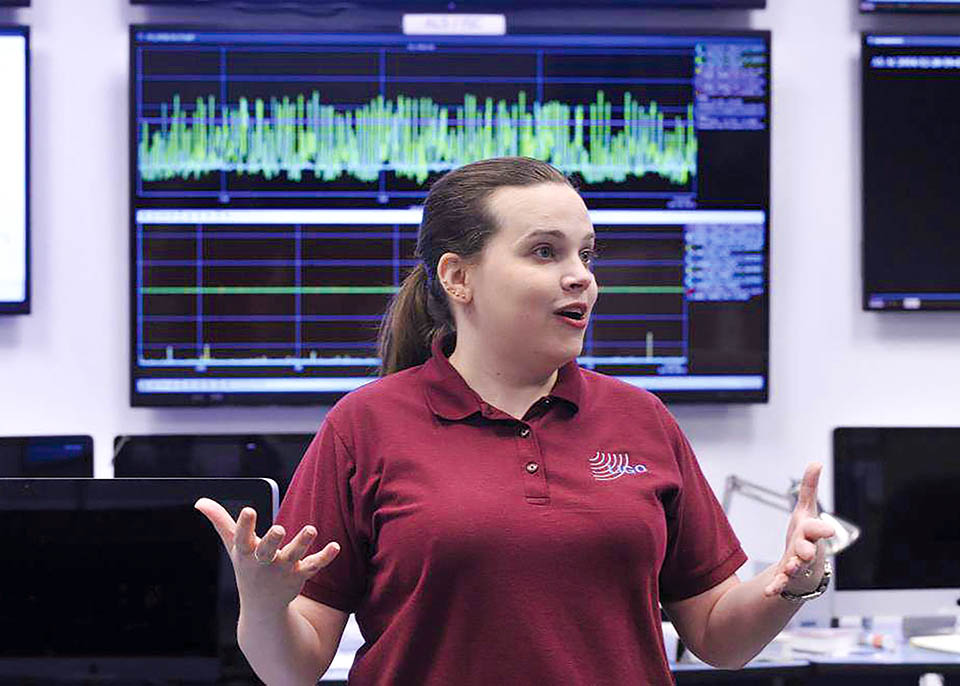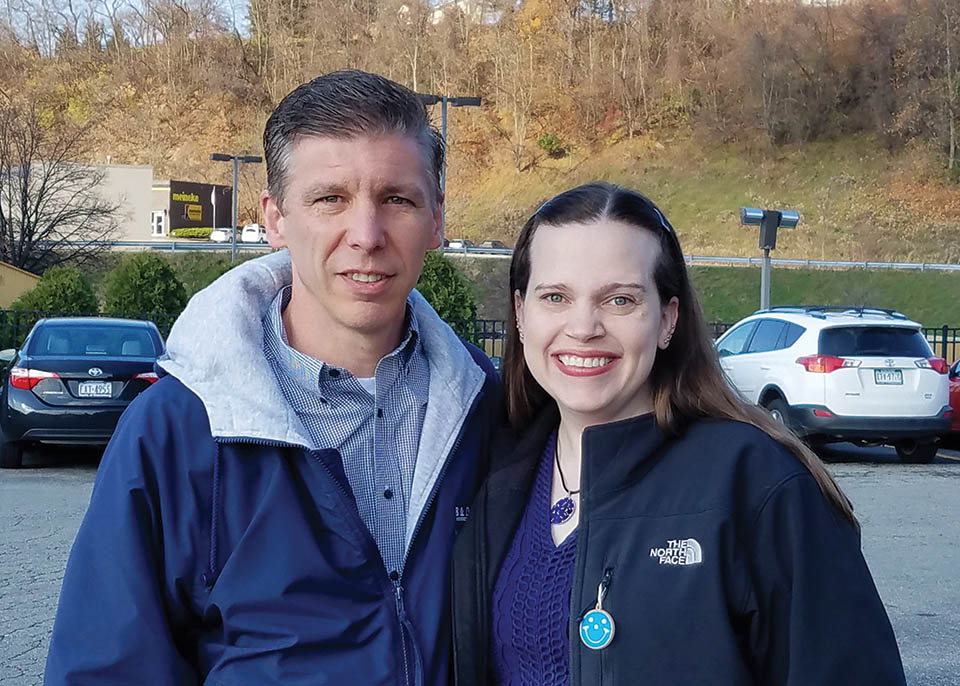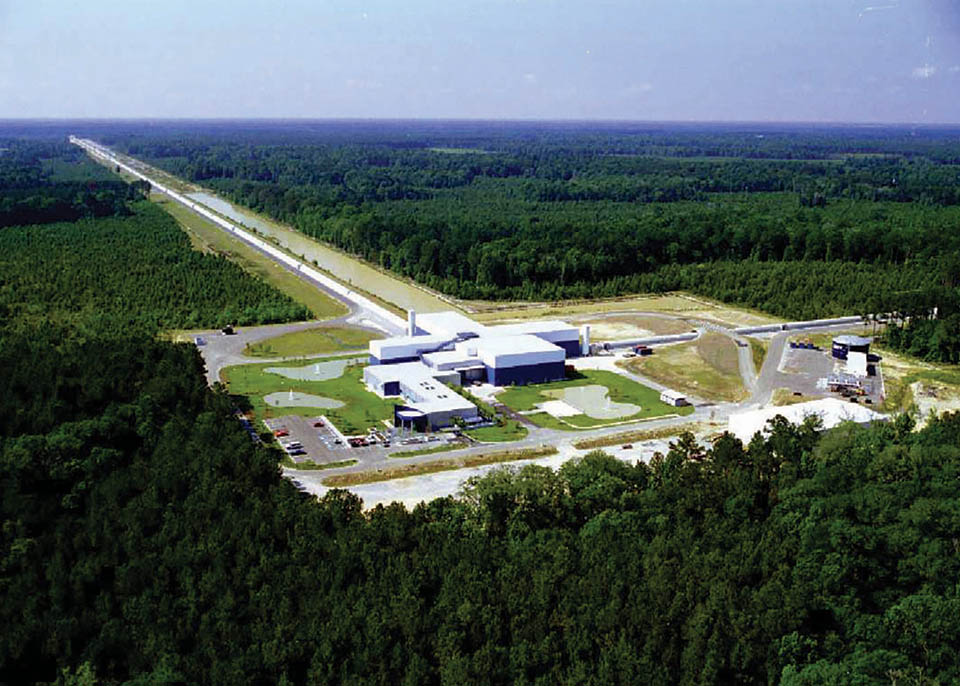Good Vibrations: Alumna Has Role in Groundbreaking Deep Space Discovery
Oct 3, 2017 12:00 PM
(Editor's Note: This story first appeared in Spring 2017 Profile. Three scientists who led the research on the discovery of gravitational waves were awarded the Nobel Prize in Physics on Oct. 3, 2017. Stuver's work at LIGO concentrated on the discovery that is now honored with the Nobel Prize. Today, Stuver is an assistant professor at Villanova University.)
By Charles Schelle
As her head was buried in electricity and magnetism homework at the Lane Center, Amber Stuver ’99 sensed a disturbance in the force.
The unmistakable squeaky shoes of physics professor Dr. George Plitnik pulsated into her atmosphere. Once he made his presence known, she looked up, hoping that the longtime physics professor could swing by like a comet, provide some light and leave.
Instead, his words hit her like the Big Bang.
“He looked down, looked at the problem and he said, ‘Amber, if you can’t do this, you can’t cut it in grad school,’” Stuver recalled.
Despite the harsh assessment, it was illuminating.
“The truth is, he was absolutely right,” she said, recalling the most difficult course she took at FSU.
Today, she’s Dr. Amber Stuver, with a doctorate in physics from Penn State University. She makes her living looking for disturbances in the space-time continuum that are so difficult to detect that even Albert Einstein wasn’t sure how to go about it.
Stuver is part of a team of ground-breaking scientists who were the first to detect the existence of gravitational waves and black holes — a revolutionary feat that has puzzled the best of scientists since Einstein first predicted them in his general theory of relativity.
“This is the birth of gravitational wave astronomy and an entirely new way of observing the universe,” Stuver said.
That work takes place mainly at one of two Laser Interferometer Gravitational-Wave Observatory Livingston laboratories. Stuver works at the Livingston, La., laboratory on a dual appointment as a data analyst and education and public outreach scientist.
At LIGO, Stuver writes computer programs that simulate gravitational waves and separate noise – such as an airplane flying overhead – from actual waves. That work helps other scientists working on the project determine if gravitational waves have really been detected. She also speaks to visiting groups to the science education center on site.
LIGO is operated by California Institute of Technology and Massachusetts Institute of Technology and supported by the National Science Foundation. Stuver has worked with LIGO’s research through a collaboration since June 1, 1999, a few weeks after her graduation from FSU as she prepared to start at Penn State.
“I like to say I’m the scientists they let people talk to,” Stuver joked, “which is unfair to my colleagues. I like to specialize in communicating this complicated science into something that everybody can understand.” She continues that outreach through her Living LIGO blog and on Twitter @livingligo.
Stuver is also an instructor of physics and astronomy at Louisiana State University, training future science teachers.
Making waves
Gravitational waves are ripples in space from massive objects, like stars or black holes, rotating so fast that they travel far throughout the universe, distorting the universe’s space-time like choppy waves on the Chesapeake Bay. The waves provide different, new information about the universe.
The gravitational waves are believed to be from two massive black holes that were rotating around each other before they combined into one, an occurrence 1.3 billion light years away in deep space. Scientists are still unsure why these black holes orbited each other before combining, but there is some hope that discoveries like these can explain our universe’s origin.
The discovery was first made on Sept. 14, 2015, and announced after scientists checked to make sure the data and graphs depicting gravitational waves was real.
“It’s exciting!” she said. “There had been over 16 years of nothing. I had spent my entire career waiting for this moment.”
The LIGO lab is a large building with sensitive detection equipment, including two vacuum chamber arms that form an L shape, extending about 2.5 miles in each direction.
Another LIGO Laboratory in Hanford, Wash., picked up the same wave within 1.1 milliseconds, alerting scientists around the world working with LIGO data that this was the real deal.
“We all looked at this and said it’s probably a gravitational wave. But at that point, our job was to prove it wasn’t a gravitational wave,” Stuver said, explaining the steps involved in double-checking results, which included standard inquiries to see if the researchers might have sabotaged or misinterpreted results.
Everything checked out and scientists went public with the results on Feb. 11, 2016. Another detection made Dec. 25, 2015, has since been made public, too.
While some scientists hope the discovery can answer questions about the universe’s origins, by potentially finding relic gravitational waves from the Big Bang, Stuver is excited about the ongoing mystery of what is out there.
“Every time humans looked at the universe in a new way, we always looked with a motivation,” she said. “But every time we look at the universe in a new way, we always find something we never expected to find.”
Bobcat Inspiration
And it was an FSU connection that set Stuver on this path.
Her advanced placement physics teacher at Hempfield Area High School in Greensburg, Pa., was alumnus Chuck Bowman ’91, who showed Stuver the possibilities that physics could unfold.
Stuver wanted to get to that point as soon as possible, so between taking community college courses and having AP credits in her pocket, she entered FSU as a sophomore in 1997, graduating two years later ready for graduate school at Penn State.
“Amber was one of the best we ever had,” Plitnik said. “She was very, very motivated.”
She didn’t slow down at FSU, loading up on a tough course schedule that included a 23-credit semester that her advisor Dr. Greg Latta signed off on. Latta encouraged her, but assured her it would be OK if she needed to drop a class.
Stuver is grateful that Latta was confident in her ability to take on such a demanding course load.
“What was really heartening for me was there was somebody looking out for my best interest, even though what I was doing, to some people, would be crazy,” she said.
Latta, who keeps in touch with Stuver, says she is an example of how you really can go anywhere from Frostburg State.
“It’s a tremendous inspiration,” he said.
Her courses at FSU readied Stuver for the demands of learning the weird side of physics in graduate school.
“It was a little bit hard in that I wanted to go do this thing that was a lot more complicated, that says take everything you learned and throw it away, because things get weird now,” Stuver said. “But you need a good foundation before you get to the weird, and Frostburg gave me that foundation.”



